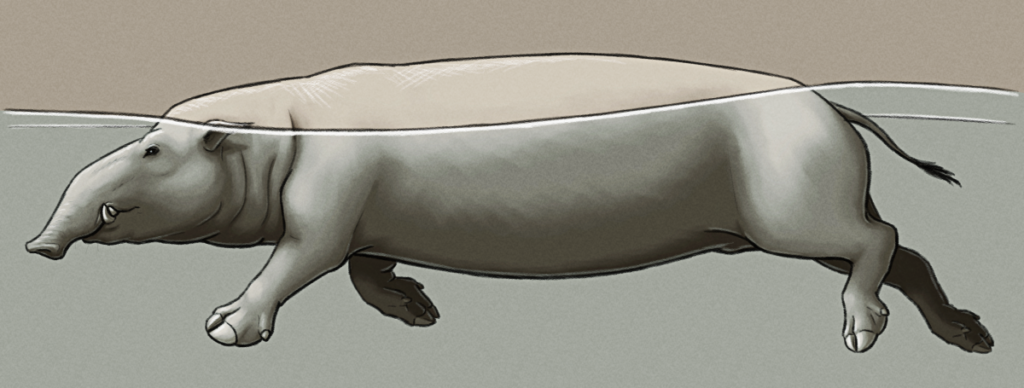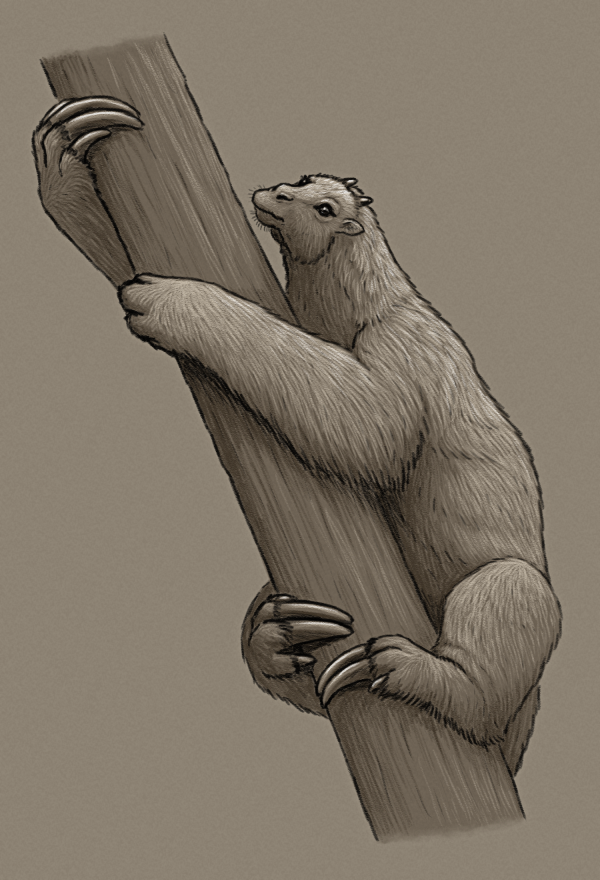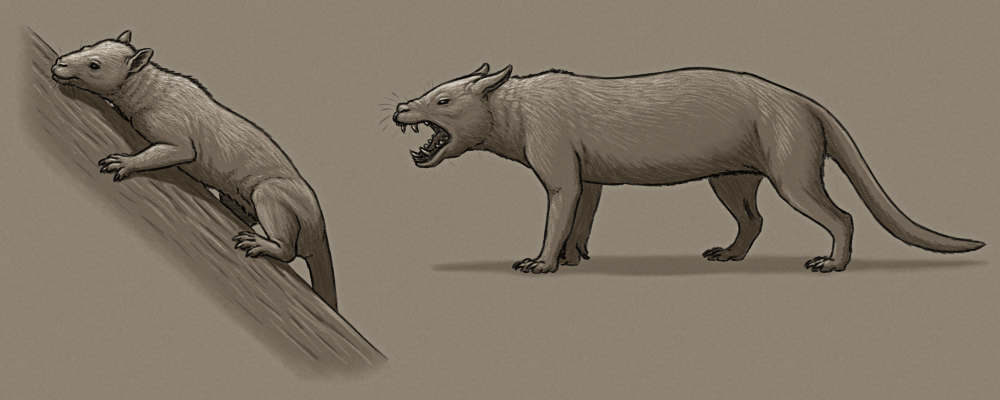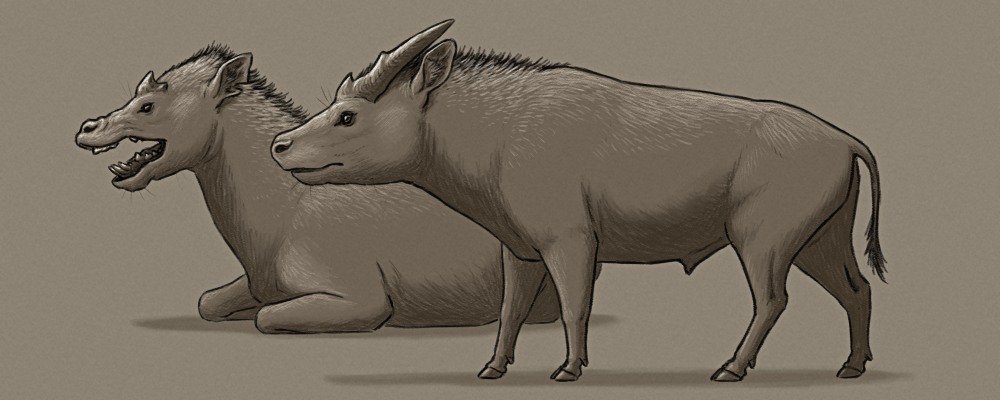It’s time for a little bit more recent PBS Eons work this week:
• The metatherian predator Arctodictis and the litoptern ungulate Thoatherium from “The Mystery of South America’s False Horses”
Paleontology and science illustration, and feathering ALL the dinosaurs
It’s time for a little bit more recent PBS Eons work this week:
• The metatherian predator Arctodictis and the litoptern ungulate Thoatherium from “The Mystery of South America’s False Horses”
Albireonids were an early branch of the delphinoid whales, with their closest living relatives being modern oceanic dolphins, narwhals and belugas, and porpoises. Known from temperate latitudes of the North Pacific Ocean between the late Miocene and the late Pliocene, about 9-2.5 million years ago, their fossil remains are very rare in coastal deposits and they seem to have primarily been offshore open ocean animals.
Albireo whistleri is the best known member of this family, represented by a near-complete skeleton from what is now Isla de Cedros in Baja California, Mexico, dating to the late Miocene between about 8 and 6 million years ago. It was a rather small dolphin, around 2.5m long (~8’2″), with a stocky body, fairly broad flippers, and skull anatomy with some convergent similarities with the modern Dall’s porpoise.
Interestingly these dolphins also seem to have frequently had pathological neck vertebrae, with both Albireo whisteri and the younger species Albireo savagei from California, USA, showing unusually asymmetrical atlas bones – but on opposite sides to each other. This might be due to illness or injury earlier in life, or possibly be evidence of some sort of “handedness” with individuals preferring to perform some actions more with one side of their body than the other.
Continue reading “Albireo”Romaleodelphis pollerspoecki was a dolphin-like toothed whale related to the ancestors of both modern oceanic dolphins and beaked whales, living in coastal waters covering what is now Austria during the early Miocene about 22 million years ago.
Although only known from a single fossil skull, this cetacean was probably around 3m long (~9’10”). It had a long snout lined with over 100 small pointed uniformly-shaped teeth, and the bony walls of its inner ears were well-preserved enough to show that it was able to hear narrow-band high frequency sounds – a specific form of echolocation that has convergently evolved multiple times in various modern and extinct toothed whale lineages.
Based on the presence of ancient river-mouth deposits in the area where Romaleodelphis was found, it may potentially have been capable of traversing between marine, brackish, and freshwater environments similar to the modern franciscana.
Continue reading “Romaleodelphis”An anonymous submitter asked for a “buoyant ungulate that runs atop the sea”:

Pontoporcus plotus is a 1.5m long (~5′) amphibious pig descended from a feral population of domestic pigs left on a small tropical island. After inadvertently wreaking havoc on much of the local ecosystem, its ancestors eventually turned to a more marine-based lifestyle foraging along beaches and in coastal waters.
Naturally highly buoyant, Pontoporcus actually floats so well that it’s mostly limited to the water’s surface, unable to dive to any significant degree. But despite this it’s a fairly good swimmer, using broad hooves with wide fleshy pads to paddle itself along in an aquatic trotting- or running-like gait.
It forages both on land and in the water, mainly eating soft vegetation and marine plants, but much like its ancestors it will also opportunistically feed on whatever smaller animals it can catch or scavenge. Its semi-prehensile trunk-like snout is used to grasp at food items, to probe and root around in soft sediment, and as a snorkel.
Its hairless skin is very susceptible to sunburn, but it secretes a thick oily red-brown substance (similar to modern hippo “blood sweat”) that acts as a natural protective sunscreen.
These pigs are accomplished island-hoppers, regularly traversing the relatively shallow seas all along their island chain – but their natural flotation and long fat bodies also make them prime targets for large aquatic predators attacking from below, so these journeys tend to involve groups of Pontoporcus “running” along the sea surface aiming for their next destination as fast as they possibly can.
It’s been a while, but let’s catch up with some more work I’ve done for PBS Eons:
The enigmatic Paleodictyon, from “Something Has Been Making This Mark For 500 Million Years”
The archaic ungulates Loxolophus, Arctocyon, and Eoconodon, from “How a Mass Extinction Changed Our Brains”
And the nautilid Aturia, from “When Nautiloids Met Their Match”
Aureia rerehua was a toothed whale that lived during the late Oligocene and early Miocene, around 23-22 million years ago, in shallow coastal waters covering most of what is now Aotearoa New Zealand.
It was closely related to the waipatiids – a group traditionally classified as platanistoids (the South Asian river dolphin lineage), but more recently proposed as instead representing a separate earlier branch of the toothed whale evolutionary tree.
About 2m long (~6’6″), Aureia had distinctive tusk-like teeth that splayed outwards from its snout, interlocking when its mouth was closed. Along with a flexible neck and its fairly delicately-built skull and jaws, this suggests it was specialized for catching small prey in a “fish trap” of teeth, a unique feeding strategy for a toothed whale.
Along with different feeding specializations in other close relatives like Nihohae, Aureia shows us how multiple species of these ancient Aotearoan cetaceans were able to coexist in the same place and time by diversifying into different novel ecological niches.
Continue reading “Aureia”Ninoziphius platyrostris was an early beaked whale that lived during the late Miocene (~6 million years ago) in warm coastal waters covering what is now southwestern Peru. Its ancestors appear to have branched off from all other beaked whales very early in the group’s history, indicating a “ghost lineage” going back to at least 17 million years ago.
About 4.4m long (~14’5″), it was less specialized for suction feeding and deep diving than modern beaked whales. Also unlike most modern species its jaws were lined with numerous interlocking teeth, with heavy wear suggesting it may have hunted close to the seafloor, where disturbed sand and grit would have regularly ended up in its mouth along with its prey and steadily ground down its teeth during its lifetime.
Males had a pair of stout tusks at the tip of their upward-curving lower jaw, with possibly a second smaller set of tusks behind them, which were probably used for fighting each other like in modern beaked whales.
Its shallow water habitat and more abrasive diet suggest Ninoziphius’ lifestyle was much more like modern dolphins than modern beaked whales, and other early beaked whales like Messapicetus similarly seem to have occupied dolphin-like ecological niches.
These dolphin-like forms disappeared around the same time that true dolphins began to diversify, possibly struggling to compete for the same food sources, while other beaked whales that had begun to specialize for deep sea diving survived and thrived. Interestingly this ecological shift seems to have happened twice, in two separate beaked whale lineages – although only one of them still survives today – with bizarre bony “internal antlers” even independently evolving in both groups.
Continue reading “Ninoziphius”Cadurcodon ardynensis was an odd-toed ungulate that lived in what is now Mongolia during the late Eocene, about 37-34 million years ago.
It was around 2m long (6’6″) and, despite its very tapir-like appearance and lack of horns, it was actually closer related to modern rhinoceroses – it was part of a group of early rhino-cousins known as amynodontids, which convergently evolved both hippo-like and tapir-like lifestyles.
Cadurcodon was the most tapir-like of the tapir-like amynodontids, with a short deep skull and retracted nasal bones that indicate it had a well-developed prehensile trunk. Males also had large tusks formed from their upper and lower canine teeth, which may have been used for fighting each other.
Continue reading “Cadurcodon”An anonymous submitter asked for an “arboreal goat with grasping sloth-like claws”:

Cluraix cephalula is a distant descendant of feral goats in a tropical forest environment, representing a small tree-climbing offshoot of a specialized chalicothere-like lineage.
About 70cm long (~2’4″), it clambers around in the high tree canopies, with its forward-facing eyes providing good depth perception in this complex three-dimensional habitat. Its long hooked claw-hooves are used both to cling onto branches and to hook-and-pull clumps of foliage towards itself, stripping the leaves with its flexible fleshy lips.
An anonymous submitter asked for a “derived carnivorous, pack-hunting agriochoerid“:

Felichoerus ochlos is fairly similar-looking to its herbivorous relatives, but this cat-sized agriochoerid comes from a lineage that initially specialized in eating fleshy fruits – and then shifted towards eating actual flesh.
With its long cat-like body, forward-facing eyes, clawed digits, and flexible limbs, it’s a capable tree climber. Groups of this animal practice cooperative hunting, with one member chasing arboreal prey down to the ground for the rest to mob.
And another anon wanted to see an “obligate carnivore bovine”:
(I see what you did there. A literal carnotaurus!)

The bulltcher (Carnovitulus grassator) is a sheep-sized descendant of small buffalo that gradually took up more and more omnivorous diets, eventually becoming somewhat entelodont-like opportunists. This particular species has shifted over into hypercarnivory, occupying a predator niche in an ecosystem lacking other types of carnivorous mammal.
Like their ancestors they still lack upper front teeth, and instead have modified their dental pad into an almost beak-like tough keratinized structure that their sharp lower teeth can slice and self-sharpen against.
These animals live in small matriarchal herds, with bulls usually hanging around on the edges of the group to protect from threats. Bulls have larger backwards-pointing horns, used to compete with each other for mates – but the size of these structures on their skulls results in them having slightly less powerful jaw muscles than cows.
Herds hunt cooperatively, pursuing and harassing larger prey until it can be brought down and torn apart.